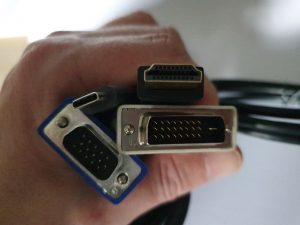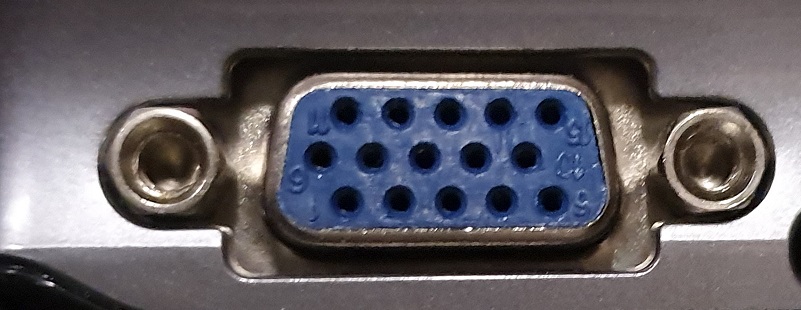
VGA or Video Graphics Array
Introduced: 1987. Superseded by: DVI
VGA was the first computer connector introduced during the analog era when mainframe computers were still in vogue. VGA’s have 3-row 15 pin DE connectors, and they are found in many computers manufactured before the year 2000. A VGA is used to transmit data from computers CPUs to the monitor, but they are also found in many video cards and television sets. Some laptops manufactured decades ago also spot mini VGA ports instead of the larger type found on its bigger cousins.
Cable: VGA cables come in varieties of specifications depending on signal bandwidth. Below are the various bandwidths and their appropriate cable lines
- 320×420 px – 70Hz
- 320×480px – 60Hz
- 1280x1024px – 85Hz
- 2048x1536px – 388MHz
DVI or Digital Video Interface
Introduced: 1999. Succeeded the VGA. Superseded by: Display Port, HDMI
DVI was developed by Display Working Group (DDWG) to help computer users overcome the limitations of the VGA which could not transmit digital data. A DVI connector simply connects a video source to a display device which could be a computer monitor. Although they were introduced two decades ago, they remain quite popular, and system manufacturers continue to use them for their functionality. DVI’ can be used to transmit uncompressed digital video but beyond that, they can also be configured to support multiple mode transmitters. This connector type is compatible with VGA and most modern-day computers and electronic devices such as television sets and DVD players.
Cable: DVI have varieties of cable lengths such as
- 15ft cables suitable for 1920×1200 display resolution
- 49ft cables suitable for 1280×1024 display resolution
HDMI or High-Definition Multimedia Interface
Introduced: 2002. Succeeded the DVI connector. Superseded by: Display Port.
HDMI is a high proprietary video and audio interface connector used for transmitting uncompressed and compressed digital video and audio data from a source device that is HDMI compliant. The HDMI was introduced as a replacement for analog video standards, and it happens to be the most used connector port currently. The model was designed by the 7 HDMI founders’ company and works well with Display controllers, digital Television sets, digital audio devices, and video projectors. HDMI’s are commonly found in Compaq and HP Desktop computers. Unlike other connectors that place emphasis on cables, this connector works with Type ratings.
Type A, C and D = 19 pins
Type B = 29 pins
DP or Display Port
Introduced: 2006. Succeeded: HDMI. Superseded by: USB -C
A Display Port is a modern interface designed for the connecting of a target display device to a video source. Display Port can be used to extract audio and video files from USB and other forms of data sources. Display Port was designed to replace the outdated VGA connectors, legacy DVI’s and the short-lived FPP-links. Although DVI and HDMI connectors still hold away at the moment, Display Port will gradually gain prominence in the coming years as device designers adopt it as the gold connector standard.
Cables: Display Port cables are compatible with Display Port devices of any version. Most ports work with all four transmission modes, and they support higher bandwidths than other connectors mentioned in this article. It is important to note they, not all Display Ports support all four transmissions though.
Display Ports are classified based on their bandwidth
- RBR (Reduced Bit Rate) – 6.48Gbit/S Bandwidth
- HBR (High Bit Rate) – 10.80 Gbit/S Bandwidth
- HBR2(High Bit Rate2) – 21.60 Gbit/S Bandwidth
- HBR3(High Bit Rate3) – 32.40 Gbit/S Bandwidth
Mini Display Port
Mini display port is a miniaturized version of the HDMI version introduced by Apple in October 2005. When they came into prominence, Apple used them on all their Macintosh computers, but over time, they began to phase them out in place of USB- C connectors. Mini display ports were necessary at the time because system designers needed a smaller substitute for the larger HDMI’s hence their production. They are also found on Led Cinema Display screens and some modernized digital tv sets.
USB-C or Universal Serial Bus Type-C
Introduced: 2014. The latest connector version
USB-connectors were introduced in 2014, and they come with 24 pin double sided connectors for video file conversions into HDMI using an adaptor. Being the newest invention of all connector series, Apple decided to utilize them majorly for their Mac book series which is why USB-C Ports are the only ports found on newer versions of MAC Book Pro. Not all USB-C connectors are of the same capabilities. Although they work well with MAC operating systems, they tend to produce lower visual quality when used on Windows systems.
Cables: USB-C cables are paired based on their configurations.
- USB-C cables with 3.1 Gen 2 configuration can handle up to 10 Gbit/S data rate
- USB-C cables with 2.0 configuration can handle up to 480mbits/S data rate
Conclusion
As can be seen, VGA’s are no longer in use, and with time they will be phased out permanently. DVI’ however will still remain relevant for a time, but with the full deployment of HDMI and Display Ports, DVI’s will gradually leave the scene just like it’s an older cousin. Whichever port you choose to go for on any device, make sure you use the appropriate cable spec for maximum visual quality.

















Really useful information
This was very helpful in keeping older equipment in action with newer devices. I purchased new CPUs and with your details, I was able to get the right (and inexpensive) connectors for the monitors I already have. I now have double monitors on all CPUs AND saved a few hundred not having to replace older, but still working monitors . Thank you for the great detail!
Ah good news Lisa. Glad that we could help with our info!